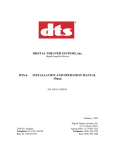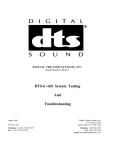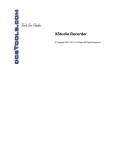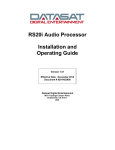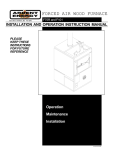Download Classe Audio CP-65 Instruction manual
Transcript
R DIGITAL T HEATER S YSTEMS Digital Sound for the Movies INSTALLATION AND OPERATION MANUAL 35MM DTS-6D October 16, 1998 Digital Theater Systems 5171 Clareton Drive Agoura Hills, CA 91301 USA Phone - 818.706.3525 / 800.959.4109 Fax - 818.706.1868 DTS SA, England Telephone: 44-1491-413649 Fax: 44-1491-413621 i EMI NOTICE This equipment has been tested and found to comply with the limits for a Class A digital device, pursuant to Part 15 of the FCC Rules. These limits are designed to provide reasonable protection against harmful interference when the equipment is operated in a commercial environment. This equipment generates, uses, and can radiate radio frequency energy and, if not installed and used in accordance with the instruction manual, may cause harmful interference to radio communications. Operation of this equipment in a residential area is likely to cause harmful interference in which case the user will be required to correct the interference at his own expense. Canadian Department of Communications compliance statement: This equipment does not exceed Class A limits per radio noise emissions for digital apparatus set out in the Radio Interference Regulation of the Canadian Department of Communications. Operation in a residential area may cause unacceptable interference to radio and TV reception requiring the owner or operator to take whatever steps are necessary to correct the interference. Avis de conformite aux normes du ministere des Communications du Canada: Cet equipment ne depasse pas les limites de Classe A D'emission de bruits radioelectriques pour les appareils numeriques telles que perscrites par le Reglement sur le brouillage radioelectrique etabli par le ministere des Communications du Canada. L'exploitation faite en milieu residentiel peut entrainer le brouillage des receptions radio et television, ce qui olbigerait le proprietaire ou l'operateur a prendre les dispositions necessaires pour en eliminer les causes. PATENTS The DTS system has been granted the following patents: U.S. Patent Nos. 5155510, 5386255, 5450146, 5751398 Australia Patent Nos. 652965, 661614 Europe Patent Nos. 0551424, 0615631, 0473677, 0632922 Japan Patent Nos. 2033555, 2708961 India Patent No. 181427 Russia Patent No. 2088962 Korea Patent No. 153028 France Patent Nos. 8906807, 9114963 March 9, 1999 i WARRANTY INFORMATION Equipment manufactured by Digital Theater Systems, L.P. is warranted against defects in materials and workmanship for one year from date of purchase. There are no other express or implied warranties. Digital Theater Systems, L.P. obligation is restricted to repair and replacement of defective parts. Under no circumstances will Digital Theater Systems, L.P. be liable for any other damage, either direct or consequential. All requests for repairs or information should include the unit serial number to ensure rapid service. RETURNS For warranty, repair, exchange or replacement parts, please call DTS at (818) 706-3525 or USA toll free 1-800-959-4109 for a Return Authorization number before sending any item back to us. At the time of the call, DTS will require that you provide the serial number of any DTS-6D unit(s) or reader head(s) to be returned before warranty replacement units will be sent. All return packaging should be clearly marked with the Return Authorization number on the outside of the package. DTS FAX: (818) 879-2746. Please send all returns to: Digital Theater Systems 5171 Clareton Drive Agoura Hills, California 91301 USA PROMOTIONAL MATERIALS Promotional materials are available from DTS. These items include: * DTS marquee signs (see order form at the back of this manual) * DTS one sheets * DTS logo films, available in scope and flat * DTS buttons and pins * DTS T-shirts * DTS Letterman’s Jackets * DTS Denim Jackets * DTS Hats * DTS Sweatshirts * DTS Tweekers Call DTS Customer Service or visit our web site for price and ordering informaion. DTS NEWSLETTERS The DTS Newsletter is published quarterly. If you would like to be added to the mailing list, contact DTS Customer Service. The newsletter is also posted on our web site at: http://www.dtsonline.com ii FACTORY WARRANTY INFORMATION The following is a list of information necessary for every location where the DTS-6D system is installed. THEATER NAME/CIRCUIT: _________________________________________ THEATER LOCATION: _________________________________________ SCREEN NUMBER: _________________________________________ THEATER CONTACT/TELE #: _________________________________________ LOCAL TECH/TELE #: _________________________________________ TIMECODE READER S#: _________________________________________ DTS-6D SERIAL NUMBER: _________________________________________ PROJECTOR TYPE: _________________________________________ SOUND PROCESSOR: _________________________________________ SOUND AMPLIFIER: _________________________________________ SPEAKER SYSTEM: _________________________________________ Screen (model): _________________________________________________ Surrounds (model): _________________________________________________ Split: Mono: __________________ Subwoofer: Is it self-powered? Subwoofer Amp (model): _________________________________________________ Are the Left Extra and Right Extra being used for Subwoofer? _____________________ DTS requires the above information to provide proper and timely technical support. Fill page out and send to DTS (address and FAX number below), attention Customer Service. ***IMPORTANT*** Failure to return this information sheet within 30 days to DTS WILL VOID your warranty. Digital Theater Systems 5171 Clareton Drive Agoura Hills, California 91301 USA Telephone: (818) 706-3525 or (800) 959-4109 FAX:(818) 879-2746 iii RACK-MOUNTED INSTALLATIONS If this product is installed in a closed or multi-unit rack assembly, the following items must be considered. 1. The ambient temperature within the rack may be greater than room ambient temperature. The maximum temperature for the equipment in this environment is 50°C. Consideration should be given to the maximum rated ambient. 2. Installation should be such that the amount of air flow required for safe operation is not compromised, and that a hazardous condition is not achieved due to uneven loading. 3. Check nameplate ratings to assure there is no overloading of supply circuits that could have an effect on overcurrent protection and supply wiring. 4. Reliable grounding of this equipment should be maintained. Particular attention should be given to supply connections when connecting to power strips, rather than direct connections to the branch circuit. 5. A quality surge / spike suppresser power strip is recommended to protect the DTS-6D processor. SYSTEM CONSIDERATIONS A DTS digital playback system can place enormous demands on the amplifiers and speakers in your theater. Some of the factors that can effect the power requirements are speaker efficiency, room size, and room acoustics. The following is a guideline of minimum power requirements: Each Screen Surround Theater Size Channels Channel Subwoofer Small Medium Large 200 WPC 300 WPC 400 - 500 WPC 200 WPC 300 WPC 400 - 500 WPC 400 W 600 W +800 W DTS-6D SYSTEM SPECIFICATIONS General Six channel configuration: Left, Center, Right, Left Surround, Right Surround, and Sub bass. Digital output available for DSP cinema processors. Holds three CD-ROM discs capable of up to five hours play time. Automatic fallback to ATYPE, SR, MONO, or NON-SYNC. Provides for picture and sound simultaneous change-over on two projector systems. Voltage output to reader uses self resetting circuit breakers instead of fuses. Frequency Response L, C, R: 20 Hz to 20 kHz, LS, RS: 80 Hz to 20 kHz, Sub: 20 Hz to 80 Hz Dynamic Range: 96 dB, all channels Size: 5 1/4” high, 19” long rack mount, 15 1/2” deep iv TABLE OF CONTENTS I PAGE INTRODUCTION ....................................................................................... 1 II UNPACKING .............................................................................................. 2 III INSTALLATION PROCEDURE ................................................................ Timecode Reader Installation ....................................................................... DTS-6D Processor Installation .................................................................... 3 3 4 IV Programming the DTS-6D ............................................................................................ 4 CHECKOUT AND ADJUSTMENT PROCEDURE ................................ Setting SPL .................................................................................................... 9 9 DTS Subwoofer in the Surrounds? ............................................................................... 9 Automatic Default Test ................................................................................. Timecode Reader Adjustment (sync) ............................................................ Fail-safe Check ............................................................................................... 10 12 12 V OPERATION .................................................................................................. Movie Discs .................................................................................................... Trailer Discs .................................................................................................... Operating Caddy-less CD-ROM Drives .......................................................... Show time Operation .................................................................................... Change-over Operation .................................................................................. Moving the DTS System ............................................................................... How the DTS-6D Affects other Cinema Processors .................................... 14 14 14 14 16 17 17 18 VII TROUBLESHOOTING ................................................................................ Inside the DTS-6D ........................................................................................ External Cable Assemblies .......................................................................... External Break-out Boards ........................................................................... Troubleshooting Tips .................................................................................... DTS Technical Support ................................................................................ 19 19 23 23 27 28 VIII INSTALLATION DIAGRAMS .................................................................. Timecode Read Head Brackets ..................................................................... Bracket Mounting Diagrams ......................................................................... Wiring Diagrams ........................................................................................... Other Helpful Documents ............................................................................. 29 29 30 - 32 33 - 47 49 - 66 DTS Timecode Track Specification ............................................................................. DTS Empirical Test Disc ............................................................................................. DTS-6D System Parts List ........................................................................................... Adding the Auxiliary Roller to the Timecode Reader Head ........................................ Dual Projector Theaters ................................................................................................ DTS Marquee Sign Order Form ................................................................................... Logic and Audio board schematics ............................................................................... Studio Application: D725, Dual input interface board, European studios ................... Digital Theater Systems * 31336 Via Colinas * Suite 101 Westlake Village, California 91362 USA Telephone: (818) 706-3525 * FAX (818) 706-1868 v 50 51 52 53 54 55 56 - 64 65 - 66 I. INTRODUCTION The DTS digital sound process for motion pictures is designed for the digital sound release of motion pictures in 6-track theaters. It is a dual system in that the digital audio data is recorded on CD-ROM discs. A special DTS timecode is printed on the motion picture print along with a conventional stereo optical soundtrack. The timecode is used by the DTS system to synchronize the sound and picture. The timecode lies between the picture and optical sound track, and is printed onto the release print from the soundtrack negative. There is a single inventory of prints. The DTS-6D system provides left, center, right, split surrounds (or mono surround) and subwoof channels. The system allows for play times up to 5 hours. They are completely automatic and fail-safe in operation requiring no action by the projectionist. The systems automatically start and stop, and track film breaks and change-overs. The digital audio data is sampled at 44.1K samples per second. APTX100 digital audio data compression (4:1) is used. Transfer into the process can be made from conventionally mixed analog or digital sound masters. How Does The DTS-6D System Work? Using DTS timecode printed on the motion picture film, the DTS-6D system (with matching movie discs loaded) reads the timecode and plays the correct sound for each frame of film projected. The projectionist inserts the movie disc(s) into the DTS-6D and threads the film though the DTS timecode reader head. Once the film is started, the DTS system checks a keyed serial number in the timecode and on the movie disc(s) to assure the correct sound is being played with the movie being shown. Films released in the DTS digital sound format also contain a traditional analog (optical) sound track (SR, A-TYPE, or MONO) which serves as a back-up sound source. If a problem occurs in the DTS digital system, the DTS-6D switches out of digital and pulses the cinema processor to the proper analog sound format. And at the end of the show, the DTS-6D switches the cinema processor to the NON-SYNC format. 1 II. UNPACKING The packaging is designed to handle normal shipping and handling. Upon receipt of shipment, check for signs of damage before opening and report all damage to the carrier. All shipments made from DTS are customer responsibility once they leave our premises. Before installation is begun it is suggested that a complete inventory be taken to minimize problems or questions during installation. Additionally, save all packing material until installation is complete in the unlikely event that a component(s) requires return to the factory. Use the packing slip that came with your unit to verify received inventory. The following is a sample packing list for a single projector (platter) system: •DTS-6D processor and power cord •Timecode Reader Head, 35mm, P/N D600 •Reader Head Mounting Bracket •Timecode Reader Head Interconnect Cable, P/N D435* •Analog Output Cable, P/N 2503-0014-00** (same part as logic cable) •Digital Output Cable, P/N D713*** •Logic breakout board (as it applies to your cinema processor) CP45 uses P/N D716 CP55 uses P/N D565 CP65 uses P/N D564 CP50/CP100/CP200 use one P/N D567 board and one P/N D711 cable CP500 uses one P/N D715 UltraStereo uses P/N D571 •Audio breakout board (as it applies to your cinema processor) CP45/CP65 use P/N D574 CP55 uses P/N D572 CP50/CP100/CP200 use two P/N D712 cables (with the D567 board, mentioned above) CP500 uses the audio output cable only (does not use an audio breakout card) UltraStereo uses P/N D575 SMART MOD V processors use P/N D714 interface cable (no DTS boards). SMART MOD VI processors use P/N D706 interface cable (no DTS boards) •Automation (logic) cable, P/N 2503-0014-00 (same part as analog output cable) •Installation Hardware •Manual •DTS trailer (logo) films, two scope and two flat NOTES: *Timecode cable for two projector (change-over) systems should change to a “Y” cable, P/N D435.. Plus, an additional reader head, mounting bracket, and hardware should be included, and the DTS-6D should be programmed for change-over operation (see Section 3.2 for DTS-6D programming details). **Analog output cable, P/N 2503-0014-00, is used with cinema processors capable of discrete multi-channel input: Dolby, Kintek, Pana-Stereo, RGM, Smart, and UltraStereo JS Series. ***Digital output cable, P/N D713 is available for digital signal processors, models UltraStereo DSP-60S and Cinema Acoustics CA-CP600. If any of the items on your packing list cannot be found, contact DTS with the P/N and description of the missing item(s). Refer to “RETURNS,” page ii, when sending any product back to DTS. 2 III. INSTALLATION PROCEDURE The DTS-6D system consist of two major components: The DTS Timecode Reader Head and the DTS-6D processor (player). The following is a generic procedure intended to supplement the processor installation wiring diagrams for specific manufacturer's sound systems. Look for these diagrams in Section VIII. 3.1 Timecode Reader Head Installation • The Timecode Reader Head is designed to be mounted onto most projectors with a single mounting bracket. • Position the appropriate DTS mounting bracket on the same bolt pattern as the reel arm and bolt securely in place (see “bracket mounting diagrams,” in Section VIII). • Install the Timecode Reader Head onto the DTS mounting bracket and bolt into place with supplied hardware. • Reinstall the reel arm on the top bolt pattern of the DTS mounting bracket. • Using some film, align the film path from the reel arm through the DTS reader mounted on a bracket and to the projector. • The DTS timecode reader MUST have a straight film path (no angles or twists) and at least a small amount of tension. The auxiliary flanged roller on the timecode reader head is used to avoid film “walk out” and helps to stabilize the film. Additional guide rollers may be added to ensure proper film tension most critical on platter systems. • Connect the 9-pin timecode cable and route to the sound processor rack for interconnect with the DTS6D processor. • Two projector (change-over) theaters Be sure to place each reader head at the same place on the projectors. The offset value must be the same for the movie to play in sync at both projectors. 3 3.2 DTS-6D Processor Installation DTS has configured your DTS-6D processor to interface to the cinema processor as indicated on the packing list. A DTS-6D labeled “generic” will be set for platter (single projector) operation. If the DTS-6D processor you are about to install did not come from the factory then you will must check an internal programming jumper. ** Be sure the rear panel AC voltage switch is properly set for your mains AC supply rating ** Remove the top cover. See Figure 1. Programming for Two Projector (change-over) Operation Locate the timecode board D422 (the card with the 9-pin D-connector on the rear panel and LED's on the front). Near top center of the board there is a 7-position header called “W1”. A shunt is required vertically over position “0” (farthest right position) if you are installing for change-over operation. Programming for One Projector (platter) Operation Locate the timecode board D422 (the card with the 9-pin D-connector on the rear panel and LED's on the front). Near top center of the board there is a 7-position header called “W1”. No shunt is required for platter operation. However, a shunt is supplied with each DTS-6D and this shunt should be in the “holding” position: Placed horizontally across the top row. Programming Special Functions The D422 board contains “W1” (7-position header) that can be used for special applications. Unless specified otherwise, all factory DTS-6D units are programmed for standard theatrical operation -- which means none of the special functions, listed below, are used. If a special function is required, use the table below to program the DTS-6D. To enable any of these applications, place a shunt vertically across the position needed to perform the operation required. “W1” Position 0 1 2 2 4 Special Function Change-over (two timecode sources) enable SMPTE timecode enable Don’t read user bits (used w/#1 enabled) Nonsync program enable (when #1 not used) Serial output of timecode After the DTS-6D is programmed, reinstall top cover. 4 5 The DTS-6D Processor (player) • The DTS-6D processor is designed to be integrated into your existing theater sound system without affecting normal theater operation. All interconnects are standalone. No cuts or jumpers are necessary on most systems. • DTS-6D processor requires 5 1/4" tall by 17" deep of 19" wide rack space for proper mounting. Select a space in the sound rack not more than three feet from the existing cinema processor to be interconnected. Bolt the DTS processor into the rack. Be sure to observe ventilation requirements specified in the beginning of this book. • Check that the DTS-6D front panel power switch is in the OFF position. Check that the rear panel AC voltage switch is properly set for your main AC supply rating. • Connect the power cable to the DTS-6D processor. (NOTE: The DTS-6D processor is a computer based system and as such can be susceptible to power line surges. A quality surge/spike suppresser made for computers is recommended. • Connect the 9-pin cable (P/N D435) from the timecode reader head to the back of the DTS-6D processor. • Refer to wiring drawings in Section VIII that relates to your specific installation. Connect the analog and logic cables/cards to your cinema sound processor. If installing to a SMART cinema processor, contact SMART directly: Telephone (800) 45-SMART. DTS does offer SMART interface cables, for MODV use D714 and MODVI use D706. • You may connect the DTS-6D into sound racks that contain digital sound systems from Dolby and Sony. See Section VIII “Wiring Diagrams” for installation details. • The DTS-6D uses caddy-less CD-ROM drives. “Caddy-less” means the drive will not accept a CD-ROM disc in a caddy or case. Instead, you must remove the disc from its case and place it on the CD tray. See Section V “Caddy-less CD-ROM Drives” for details. • The DTS-6D has three CD-ROM drives. Drives “A” and “B” should be used for DTS movie discs and Drive “C” should be used for DTS trailer discs. You may, however, play movie discs in any of the three drives. 6 7 8 IV. CHECKOUT AND ADJUSTMENT PROCEDURE A SPL meter and the DTS technician’s kit (not included with the DTS system) are required to complete the checkout and adjustment procedure. The DTS technician’s kit consists of: * 6-track SETUP Disc, DS1 Used to adjust DTS-6D levels, check automatic default switching, and verify operation of the drives. * “Buzz and Bill Show” Disc Used to test the DTS system. Must be dated Feb. 1, 1999 and have SMPTE RP200 standard. * Demo Film Used with the “Buzz and Bill Show” disc. * Empirical Test Disc Used to test the theater’s sound system. Must be dated June 7, 1997. * DTS trimpot tweeker * DTS T-shirt 4.1 Setting SPL (Sound Pressure Level) The theater sound processor’s B-chain must be checked and adjusted before the DTS system is installed. Any changes to the B-chain will effect the output levels on the DTS system. Introduction The output levels are factory preset at 250mV rms. This nominal level will insure that speakers will not be overdriven during the setup procedure. If the DTS-6D processor you are about to install has come from another installation, be sure to turn down the level trimpots (counter-clockwise) before proceeding to guard against accidental overdriving of speakers. During the setup procedure, the output levels should be adjusted for correct SPL levels in the theater. Subwoofer The DTS subwoofer output level ranges from 20Hz to 80Hz, up to 27dB above reference (85dB). You must observe your subwoofer’s specifications to avoid damage to the speaker. If a subwoofer is driven below its cutoff frequency, its driver(s) may become unloaded. When unloaded, the voice coil can travel outside of the magnet’s gap, thus overheating or causing mechanical damage to the speaker. A high pass filter should be installed on those speakers with high cutoff frequencies. Contact your speaker manufacturer for more information. •DTS Subwoofer in the Surrounds? The DTS subwoofer signal is derived by filtering out the surround signals from 80Hz and below. That signal is put on its own “subwoofer” output on DTS player. You may verify this while EQ-ing a theater. Insert the DTS Setup disc into the player and play the subwoofer pink noise off the disc. Turn off the subwoofer speaker and look at the pattern on the RTA. You’ll see a dramatic roll-off at 80Hz. It is normal to hear DTS subwoofer pink noise, above 80Hz, in the surrounds. Setting DTS-6D Levels (see Figure 4) Turn power on and load the SETUP DISC -- use RevC or DS1 to set levels. After a delay of about 40 seconds, the SYSTEM light will blink. Then the DIGITAL light and the CD-ROM light will illuminate and the cinema processor will change to digital format. Tone should be heard in the theater. Open the screen curtains. Go into the theater to make SPL readings in the rear third and just off-center of the room. Do not simply point the sound pressure level meter out of the port hole window. This will not give you accurate SPL readings. See the next page for SPL settings. 9 •Adjust the DTS-6D levels Use the DTS 6-CHANNEL SETUP DISC, REV. DS1. This disc contains the following signals: Set the DTS-6D for these output levels: •left channel PINK noise •Left surround PINK noise high passed at 80Hz •Center channel PINK noise •Right surround PINK noise high passed at 80Hz •Right channel PINK noise •Sub Bass channel PINK noise low passed w\DTS filter •PINK noise: Left, Center, Right, Left Surr., Right Surr. 1:00 1:00 1:00 1:00 1:00 1:00 0:04 each SPL 85dB 82dB 85dB 82dB 85dB 91dB NOTE: SPL readings should be measured unweighted, or C weighted -- slow February 9, 1999 Remove the black cover by unscrewing the two black Philips screws from the front panel. With ALL power amplifiers turned on, master fader set to reference position “7” and speakers unmuted, adjust the appropriate trimpots (see Figure 4) on the DTS-6D processor to achieve the specified SPL noted above. MONO SURROUND For those theaters with mono surround only, wait for either the left -or- the right surround PINK noise when adjusting the MONO SURR trimpot for 82dB SPL in the theater.. Index Switch A small black momentary push button switch located below the TIMECODE HEAD OFFSET switches (Figure 3). It is commonly called the “index switch”. This button can be used to increment to the next track being played. This feature works on the DTS 6-TRACK SET UP discs Rev. C and Rev. DS1 only. On shows of serial number 1009 and higher, the momentary button also bypasses the DTS-6D processor to allow checking of the optical bypass function. •Test The Automatic Default Functions The default programming is now part of the programming on DTS movie discs. Movie discs made after June96 will automatically default to the optical format present on the film. Automatic default is available for MONO, ATYPE, or SR format. Also, cinema processors will be pulsed to the NON-SYNC format at the end of a feature film played in DTS digital sound. Testing this feature works only with the DTS 6-TRACK SET-UP Rev. DS1 disc. Load the SET-UP disc in the DTS6D and stand next to the unit when performing this test. To start, allow the right channel’s pink noise to play in the theater. Eject the disc by pushing the open/close button on the drive. The cinema processor should pulse to the mono format. Repeat procedure for the remaining formats as listed: Pink noise channel Default Format Left Surround Center Right A-type Non-sync SR Mono 10 11 4.2 Timecode Reader Adjustment. See Figure 5. • Eject the SETUP DISC and insert the DTS 6-TRACK DEMONSTRATION D-1 disc. Thread the DEMO REEL through the projector and the DTS reader head. • The DEMO REEL has a specially printed leader for setting the timecode head offset. Start with the offset measurement start mark, “00”, at the timecode head’s red LED (inside the lens). Read the number at the projector’s optical sound head and set the DTS processor TIMECODE HEAD OFFSET switches to this offset number. The offset number must be between “15” and “70”. If the offset is not within these parameters, relocate the reader head(s) on the projector(s) until a valid number is achieved. • If no DEMO REEL is available, delay can be calculated by counting the number of picture frames from the DTS reader head red LED (lens) to the projector’s picture (“film”) aperture. Multiply the result by 1.25 and subtract one. Set the TIMECODE HEAD OFFSET switches to this number. EXAMPLE: 27 frames X 1.25 = 33.75 - 1 = 32.75 offset. Round this number off to the next whole number. So, “33” would be the offset number. REMEMBER: When using the counting frame method, frames are counted from the timecode reader lens to the picture aperture. And, when using the numbered film strip method, thread projector with the “00” at the timecode reader lens and read the number at the optical sound head (solar cell). IMPORTANT: Make the same size film loops inside the projector when measuring the offset as when running a movie. Failure to do so will result in improper sync when the movie runs in DTS digital sound. • Run the DEMO REEL. The green light on the Timecode Reader Head should light when timecode is read. The light should be bright and steady. • Listen test. Go into the theater. Watch and listen to the demo film. Verify the sound sync to picture is correct. Check the front and back of the theater. If any delay is seen adjust the TIMECODE HEAD OFFSET switches as necessary to obtain proper sync. Listen through the entire reel to be sure that no distortion or breakup occurs. If running a change-over theater, play the demo film a second time through the other projector. • Check the fail-safe operation. While the film is running in digital, slip a business card into the timecode reader head, (between the film and the lens as to block out the timecode from being read) for at least six seconds, while the show is running. The cinema processor should switch back to the optical format. There should not be a dramatic level difference between optical and digital sound (in a quiet scene). If there is, recheck the “B” chain and the DTS-6D level settings. Remove the business card and verify the cinema processor switches back to digital format within six seconds. 12 13 V. OPERATION •Verify DTS Movie Discs DTS movie discs are issued to theaters from the film’s studio distribution company. Make sure your discs match the movie (e.g. “Jurassic Park” film with “Jurassic Park” movie discs). If the film and discs don't match the digital sound track will not play. Movies running over 90 minutes will have two movie discs: One labeled 6-track A and another labeled 6track B. These discs can be inserted into the A & B drives in any order. Only one movie disc is needed for movies running at/under 90 minutes. These movie discs will be labeled “one disc only”. You may place the single disc into either the A or B drive. Any trailers added to DTS movie disc(s) will be listed on the front of the movie disc(s) Load only ONE movie title disc (or disc set) into the DTS-6D. Never load two or more movie titles into one DTS-6D. If running a double feature, change movie discs (to second feature) and cycle power on the DTS-6D. •DTS Trailer Discs DTS trailer discs are issued to theaters from DTS. DTS trailer discs should reside in the C drive until a new trailer disc is received. Trailer titles contained on the disc are listed on the disc. If you have a DTS encoded trailer not listed, then your trailer will not play in DTS digital sound, but it will play in analog. To verify you have the latest trailer disc, contact DTS Customer Service. •Why Three CD-ROM Drives? Three CD-ROM drives expand the digital play time to 5 hours. Generally, DTS movie discs should be loaded into drives A and B, and the DTS trailer disc should be loaded into the C drive. Movie discs should reside in the A drive and/or B drive until the matching DTS formatted feature film is removed. •Caddy-less CD-ROM Drives (see Figure 6) This DTS-6D unit uses caddy-less CD-ROM drives. “Caddy-less” means the drive will not accept a CDROM disc in a caddy. Instead, you must remove the disc from its case and place it on the CD tray. To load a movie disc, open the drive’s CD tray. Power on the DTS-6D unit. Press the open/close button on the drive to slide out the CD tray. Remove any disc left in the tray. Remove the movie disc from the CD caddy (see diagram below) and place it on the tray. The disc must lay printed side up and flat in the tray. To slide the tray back into the drive, press the open/close button or gently push the drawer in. While the DTS-6D is playing in digital, do not press the drive’s buttons as it will cause an interruption in sound and reset the DTS system. Use only DTS discs. Music CDs will not work in the DTS-6D unit. 14 15 BEFORE THE SHOW • Splice in DTS encoded trailer films If possible, add the DTS encoded trailer (s) after all the analog trailers. Verify these trailers are listed on either your DTS movie disc(s) or DTS trailer disc. If the trailer’s title does not appear on these discs, then the trailer will not play in DTS digital sound. DTS encoded trailers will play with a noDTS feature IF its played in optical -or- the installation permits threading both readers (DTS and the other digital head). Verify the installation has been set up for this application before starting. If not sure, thread up according to the feature’s sound format. • Splice in the DTS trailer film Add the DTS trailer (logo) film to the head of the DTS encoded movie. Splice it in at about six frames after fade-out (should still have timecode) and add it directly to the first frame picture (of the movie) with timecode. • The DTS “Stand Alone Trailer” Disc Do NOT insert the “Stand Alone Trailer Disc” into the DTS-6D with any movie disc. This will cause the DTS-6D to malfunction. This disc is meant to be used when the DTS and THX trailers are attached to a non-DTS feature. All current DTS movie discs contain the DTS and THX trailers. • Threading Timecode Reader: Refer to Figure 5. Make the same size loops through the projector as when checking the offset number. • House Fader Setting Most house faders should be set to “7”. This may be readjusted for best play in the theater. NOTE: In some theaters, the subwoofer will not change with the fader. STARTING THE SHOW Less than a minute after power is turned on and the DTS movie discs are loaded, the SYSTEM light will flash. This indicates the DTS-6D processor is ready for show start. If the SYSTEM light does not flash, cycle the power on the DTS-6D: switch unit’s power off, wait 3 seconds, and switch unit on. If the light does not flash after 40 seconds, turn off the DTS-6D unit and contact DTS technical support. When DTS timecoded film reaches the timecode reader head, the green light on the timecode reader head and the TIMECODE light on the DTS-6D processor will illuminate. A second later, the DIGITAL light on the DTS-6D processor will illuminate and the DTS digital sound track will start playing. Notice that a light will sporadically flash on the CD-ROM drive whose disc is playing -- this is normal. DTS recommends the show be pre-run. Check that the green timecode reader LED is bright and steady, and the system performs properly. Check all reels for good time code, if time permits. Occasional blinking of the TIMECODE LED is acceptable. Go into the theater to listen for good sound quality and a comfortable listening level. Adjust the house fader, if necessary. •Change-over For those theaters that have two projectors, the DTS-6D processor will automatically make a sound change-over when first frame of picture timecode is read on the upcoming projector. DTS digital 16 sound changes independent of the projector’s dowser position. Adjustment of the roll down on the upcoming projector may be necessary to keep the change-over “seamless”. •Film Breaks and Edits The DTS-6D processor will automatically track any length edit. A 30 millisecond cross fade makes the edit transparent. Make sure the automation has switched to digital format after show re-start. •Maintenance The timecode reader lens should be blown off with compressed air once a day to remove any dust build up. AFTER THE SHOW When returning a DTS encoded movie back to the distributor, put the movie discs back into the yellow reel. Put the loaded yellow reel in the can with the film. Remember to remove the DTS trailer (logo) film so you may use it with other DTS encoded films. •Moving the DTS System Many theaters are moving their DTS systems from house to house following DTS movies. If you are a theater that does this, there are a few steps that must be taken to ensure proper digital playback. Give the person moving the system at least one hour’s time to complete the task. * The DTS-6D surround channels must be wired into the cinema processor and match the type surrounds (mono/stereo) present in the theater. * The DTS-6D offset switches may have to be reset. Many people have purchased extra brackets and are marking them with the offset number for that projector. Having a bracket on every projector saves time when installing/moving the reader head. Remember, the unit’s offset switches must be correct for the digital sound track to play in sync with the picture. Change-over houses must attach the reader heads at the same place on both projectors so their offset numbers match. * The DTS-6D level pots must be recalibrated for its new location. Use a SPL meter and a DTS SETUP disc to measure the pink noise in the theater. See Section 4.1. Do not simply point the meter out of the port-hole window: This will not give you proper readings. SPL readings must be taken in an empty theater with the screen’s curtain open and the cinema processor’s fader to “7”. * Whenever anything is changed on the DTS system, be sure to go into the theater at the start of the first screening. Check that the sync and levels are correct. Watch mouth movements (lip sync) on screen to verify proper offset. ** WARNING WARNING ** Failure to correctly recalibrate the “moved” DTS-6D unit will result in improper playback levels and lip sync. 17 •How DTS Affects other Cinema Processors Dolby CP50, CP100, CP200 Operation When the DTS switches to digital, the normal signal paths are interrupted. The DTS signals will be inserted just prior to the Dolby EQ cards, in effect taking over the cinema processor (CP200: Program automation optical default format to either “04” A-TYPE or “05” SR -- which ever the film requires). When the DTS-6D switches out of digital, the cinema processor is released to function as normal and default to the format previously selected. Unless modified, these cinema processors do not have a subwoofer input. DTS normally inserts its subwoofer signal after the fader control. As a result, the subwoofer level will not be effected by the fader or mute. CP200: D567 (RevB or lower) interface board, set W1, W2, W3 to DRY for standard operation. Dolby CP45, CP55, CP65, CP500, UltraStereo JS Series, and SMART Operation The DTS-6D will automatically pulse the audio processor to the digital format when it starts to play a digital sound track. Whenever the DTS-6D drops out of digital, a pulse will be sent to switch the audio processor back to the optical format. On units equipped with a DTS logic board, the pulse to switch back to optical will be blocked if the audio processor is not in the digital format. So, when the automation switches to non-sync, the DTS-6D will not switch back to optical. The DTS logic boards also have a jumper which is used to force either A-TYPE or SR as the fall-back format (installation of the jumper will override disc programming). The DTS-6D will only pulse the audio processor into the digital format when it first switches to digital. After the show has started (or the show is re-started after a film break) make sure the automation doesn’t switch the theater processor back out of the digital format. Set the automation/cues so no audio format change takes place after the DTS has switched into digital. Switching to nonsync at the end of the show is OK. CP500: Must have the Cat. 685 (analog input card) installed. DTS is normally accessed through Format 11 which is programmed in on stock units from Dolby. The DTS D715 logic jumpers must be programmed, see “Wiring Diagrams” section. SMART: ModV uses the DTS D714 and the ModVI uses the DTS D706. For other SMART cinema processors, contact Smart directly at (800) 45-SMART. Dolby DA10 / 20 SR-DTM System The DTS-6D can be connected to the Dolby SR-DTM system without effecting its performance. The DA20 connects to the appropriate DTS-6D breakout board. When the DTS-6D is off, the DA10/20 output is routed through the breakout board. When DTS is on and playing in digital, the DA10/20 connection (to the cinema processor) is switched out on the breakout card and the DTS digital sound track is given to the cinema processor. The SR-DTM system should be powered down when playing DTS. CP200: D567 (RevB or lower) interface board, set W1, W2, W3 to MONO SURR for SR-D operation TM Sony SDDSTM The DTS system does not effect nor connects to the SDDSTM system. 18 VII TROUBLESHOOTING INSIDE THE DTS-6D, see Figure 7 •D422, Rev. H TIMECODE BOARD See drawing D422. This board has the timecode head offset switches, the four system status LED lights, a 7-position programming header, a 15-pin timecode cable output connector, the U14 firmware IC, a ROM-DOS IC, an indexing switch, and fuse breaker. * The OFFSET switches are adjusted according to the timecode reader location. This setting is different depending on type of projector or location of the timecode reader. Determining the offset setting is done with either frames count method or using the DTS leader from the Demo Film. * The status LED lights: SYSTEM light flashes when the DTS-6D is ready to play, TIMECODE lights if good timecode is being read, DIGITAL lights when the DTS-6D is playing in digital, and CD-ROM lights if the drives are recognized and the discs are being read. * The 7-position header has jumper settings for different functions, most common is the setting for single projector operation. For this, the jumper is in a holder position which is across top part of the header, set horizontally between the “4” and “0”. For dual projector operation the jumper is set vertically on the “0” position. * The U14 TCR (timecode reader) firmware IC stores part of the operating software information while the rest is on the movie disc(s). * The U12 ROM-DOS IC is located near the center bottom of the board The ROM-DOS is programmed to run the CD-ROM drives and SCSI interface card. NOTE: U12 removed when using AQRM chip on Adaptec ROM interface board. * The index switch, located below the offset switches, can be used to advance though the individual channel pink noise tests on the DTS SETUP disc. It can also be used to force the DTS-6D (when playing in digital) to optical for as long as the button is held down. * A circuit breaker protects the power going to the timecode reader head (through the 15-pin connector) against short circuits. The breaker is self re-setting so replacement is unnecessary. * The 15-pin connector (accessed on the DTS-6D rear panel) is the used to connect the timecode cable to the timecode reader on the projector. 19 •D536, Rev. C PLAYBACK BOARD See drawing D536 (appears in the next few pages). Located on this board are the 7 adjustment pots that control the outputs for all channels: left, right, center, right surround, left surround, mono surround, and subwoof. The ANALOG OUT, DIGITAL OUT, and AUTOMATION outputs are also on this circuit board. •POWER SUPPLY Supplies power to the DTS-6D unit. This supply is switchable between 110 VAC and 220 VAC. This switch is located on the rear panel and on the supply module. Caution: Before applying power, verify that the AC voltage selected (on the supply) matches the mains AC supply at the installation. The cooling fan in the power supply should be rotating when power is applied. To prevent dirt from being pulled into the CD-ROM drives, do not block the ventilation holes the side of the DTS-6D player. •AVA-1501A ADAPTEC SCSI BOARD (needed for TEAC CD-ROM drives) Must be used with the PM-8002. Interfaces the CD-ROM drives to the system. •PM-8002 ROM INTERFACE BOARD (needed for TEAC CD-ROM drives) Holds the AQRM chip that contatins the current DTS.EXE file (operating software). D422-U12 not used. •MOTHERBOARD Basic input/output system. •CD-ROM DRIVES There are three caddy-less CD-ROM drives in the DTS-6D. All three are the same with exception of the way address jumpers are installed. The last drive is always terminated. The lights on the three CD-ROM drives will flash briefly when each drive is recognized during the test cycle (after power-up). The lights will also flash intermittently when movie / trailer discs are being read. Contact DTS when replacing a CD-ROM drive. 20 21 22 EXTERNAL CABLE ASSEMBLIES •6-Track Analog Audio Output Cable for DTS-6D - 2503-0014-00 (same part as logic cbl) This cable connects the 6 channel DTS-6D output to an analog cinema processor. •6-Track Digital Audio Output Cable for DTS-6D - D713 This cable connects the 6 channel DTS-6D output to a digital cinema processor. •Automation (logic) Cable for DTS-6D - 2503-0014-00 (same part as analog output cbl) This cable connects the DTS-6D logic circuitry to the cinema processor. •SMART Interface Cables The following DTS cables connect the 6 channel DTS analog output to SMART cinema processors. The SMART processor does not use any DTS external breakout boards. For the Mod V, use the DTS D714 cable. For the Mod VI, use the DTS D706 cable. •Timecode Cable Assembly - D435 This cable connects the DTS Timecode Reader Head to the DTS-6D Processor. On single projector (platter) systems, this cable has a single connector at both ends. For dual (change-over) projector systems, this cable has a single connector at one end and two connectors at the other end. See D477 for assembly diagram. EXTERNAL BREAK-OUT BOARDS •Logic Break-out Boards These boards are used to pulse to the cinema processor to the correct playback format. The analog default is automatic or can be hard-wired forced to SR or A-type. * * * * * * D716 is used with the Dolby CP45 D565 is used with the Dolby CP55 D564 is used with the Dolby CP65 D567 and one D711 cable are used with the Dolby CP200, CP100, CP50 D715 is used with the Dolby CP500. D715 contains programming jumpers that must be set correctly. D571 is used with UltraStereo •Audio Break-out Boards These boards are used to connect DTS 6-track outputs to an analog cinema processor/speaker amp. * D574 is used with the Dolby CP45 and CP65 * D572 is used with the Dolby CP55 D572 contains a programming jumper, set for MONO SURR or STEREO surround * Two D712 cables are used with the DTS D567 board (mentioned above) for the Dolby CP200, CP100, CP50 D567 RevB or lower, contains three programming jumpers, set all -3- for either DRY (standard configuration) position or MONO SURR (SR-DTM application) position. * D575 is used with UltraStereo * The CP500 does not use an audio break-out board. * D725 (dual input) is used with CP65 and audio dubber 23 24 25 26 TROUBLESHOOTING TIPS Its always a good idea to stand in the theater and listen to the first few minutes of the movie. Listen to the sound level and general quality of the sound. The sound track should be in sync with the picture (wait for a dialogue scene) and played at a comfortable level. Even though not every scene will have surround material, do your best to listen for the surround speakers. Most opening musical sequences have surround information. Be sure the movie discs match the film you are playing. Feel free to contact DTS and ask for help. •I have a DTS print but I don't have discs Contact your film distributor and ask for the disc(s). Remember. a film that runs less than 90 minutes will have only one movie disc - it should also be labeled “one disc only”. Movies running over 90 minutes and up to 3 hours & 20 minutes, will have three discs. Longer movies will have additional discs and special show instructions. •Film not in sync or doesn't sound right Turn off the DTS-6D unit. Check and listen that the movie is playing in optical format. Let the film finish playing in optical. Do not attempt to remedy these problems while playing in DTS. The theater's technician should perform a full DTS quality check with the DTS SETUP discs and verify sync with the demo film. Give the technician at least one hour to complete the test and alignment. •Volume too loud Turn down the fader pot on cinema processor. Do not adjust the DTS-6D trimmer pots behind the black panel. If sound level needs adjustment after it switches to digital, contact your theater's technician and request a B chain alignment (to DTS). •DTS-6D won't switch into digital sound - Verify movie discs are in the DTS-6D unit. Push both CD-ROM drive’s EJECT button and if nothing comes out, get the movie discs and insert them in the A and B drives. - Verify the movie discs match the movie. Push the EJECT button, and look at the movie discs. If the title doesn’t match the film, the DTS-6D will not play. Find the correct movie discs, insert them in the CD-ROM drives, and cycle power. - If the movie was recently changed, first power off the DTS-6D unit. Wait three seconds, then turn the player back on. The DTS-6D should reboot in about 30 seconds and play in digital if the correct movie discs are in the CD-ROM drive(s). - If the unit does not switch to digital, verify the green LED on the reader head (on projector) is glowing brightly and steadily while the movie is running. If the LED is dark, then verify the film is threaded through the DTS reader and that the film has a timecode strip (located between picture and analog sound track). If no timecode (dots & dashes) strip is seen, call the film's distributor and request a DTS print. •Switches out of DTS digital - The sound should automatically default to optical when the DTS-6D does not see timecode for four seconds. Verify the green LED on the DTS reader head is glowing brightly and steadily while the film is running. If the light on the CD-ROM drive(s) is on solid when film is playing, it means they cannot read disc: Try swapping discs. •Switches out of DTS digital (continued) - If the TIMECODE LED on the DTS-6D or reader head is blinking, gently squeeze the film between two fingers as it exits the reader head. Do the same at the entrance of the reader. If the LED stops 27 blinking and maintains a steady glow, this indicates that you need to add more tension. Tension is added by repositioning the auxiliary flanged roller on the reader head so that it has maximum contact with the film or by adding additional rollers. Verify all the gears in the projector are in good condition. - If the reader head does NOT have a sticker on the largest roller and the LED is not bright or is blinking, adjust the lateral screw which is located in the center of the reader head's largest roller. Turn the screw slowly one way, and if the LED does not brighten, turn slowly the other way until the LED is on steadily. - Use compressed air to blow off the reader head's lens, but never adjust the lens. - If the reader head DOES have a sticker on the largest roller, do not disturb the sticker on the reader head and do not adjust the lens. Make no adjustments on this style reader head (unless directed by DTS engineers). - Attach the grounding jumper on the timecode cable to the projector. Easiest place to do that is attach to the screw that secures the timecode cable to the reader head. The reader’s housing must be electrically connected to the projector housing. Verify with an ohm meter. This is needed for projectors that are not properly grounded. - If the drop-out occurs during the same place(s) in the movie, replace the reel(s). - In a platter house - turn off the DTS-6D unit. Take the unit out of the rack and open the lid. Look inside at the timecode card (one with LEDs). Verify the jumper is positioned horizontally across the top row of W1. The jumper should not be installed vertically (vertical placement is for two projectors only). - Do not put any sound format cues on film within timecode. Do not use leader with timecode elsewhere as it will cause a false start on the player. - Last resort is to force the unit to play in optical. Turn off the DTS-6D unit. Be sure the cinema processor switched to optical, if not manually select. Call your theater technician who should contact DTS engineers. •What do I do with the discs when the movie has finished its run? Simply return the movie discs with the film to the depot. Put the discs in the DTS yellow reel and load it into the film can. DTS TECHNICAL SUPPORT TELEPHONE: (800) 959-4109 or (818) 706-3525 FAX: (818) 879-2746 DTS engineers are available to assist you. If you have an emergency after business hours, please leave a message on the answering service and we will return your call as soon as possible. INTERNET users may email DTS at the following address: DTS Web Site. [email protected] If you have access to the INTERNET, look for the DTS web site. In our web site you will find the latest DTS news for both theater and home products. The internet address is: http://www.dtsonline.com 28 VIII INSTALLATION DIAGRAMS The diagrams on the following pages cover most 35mm installations. Contact DTS if your system does not appear. 70mm spacer kits are also available from DTS. Brackets for the DTS Timecode Reader Head, 35mm. •D614 - Standard Bracket For projectors: Century, Simplex, and Cinemeccanica with Kelmar bracket (below). Intended to fit between the projector and reel arm. We have produced the bracket with the American standard size hole to accommodate 2” center spacing 3/8 - 16 tap, that is utilized to mount the American made upper reel arms. Comes with the following hardware: QTY Description 2 10 x 24 x 1/2” long screw 2 3.4 x 16 x 1” long hex bolt nut 2 3/8” lock washer •D615 - DP70 Universal Bracket Used for American projectors with a penthouse. Comes with tap and drill bit 8-32, and the following hardware: QTY Description 2 10 x 24 x 1/2” long screws 2 3.4 x 16 x 1” long hex bolt nuts 2 3/8” lock washers •D616 - AA2 bracket For Norelco AA projectors. Comes with the following hardware: QTY Description 2 #10 lock washers 3 5/16” x 18 x 5” long screws 3 3/8” split ring lock 2 10 x 24 x 1/2” long screw •D617 - DP75 Bracket Used to mount the DTS timecode reader head to the side of the projector. Comes with same hardware as the D614. •D622 - Front Mount Bracket Used when installing multiple digital sound heads or when there is not room to lift the projector arm. Used with Dolby SR-DTM and Sony SDDSTM reader heads. •5006-0001-00 Cinemeccanica Bracket / adapter plate For Cinemeccania projectors. Must be used with the D164 standard bracket for mounting the DTS timecode reader head. If the reel arm needs to be remounted, two plates are required. Note: Cinemeccanica also has their own brackets available. Contact them directly. 29 30 31 32 Wiring Diagrams Cinema Processor To DTS-6D 33 34 July 21, 1997 DTS TECHNICAL UPDATE DTS-6 and DTS-6D To Dolby CP-45 D716 Logic Interface Board DTS-6D -- D716 Operation With The Dolby CP45 Cinema Processor “steer” each pulse to one of several CP45 formats. The DTS digital pulse is sent to external input. and are used to return the cinema processor back to the optical format the movie was recorded in. of the last reel. The J10 connector is a pass-through connection for automation. MONO JUMPER - place this jumper in the format that reflects the optical format of your trailers. Options are MONO, A-TYPE, and SR. The board is shipped in the SR position. SR JUMPER of digital. Options are A-TYPE & SR. The board is shipped in the SR position. A-TYPE JUMPER - place this jumper between the center pin and the format you wish to return to if the DTS drops out of digital. Options are A-TYPE & SR. The board is shipped in the SR position. W5 and J2 (10 pin header) are used only for operation with the DTS-6 DTS-6 -- D716 Operation With The Dolby CP45 Cinema Processor the pulse to A-TYPE or SR on the CP45. The DTS digital pulse is sent to external input . The MONO, SR and non-sync headers are not used with the DTS-6. switched to non-sync. The W5 jumper is used to bypass the optocoupler. The W5 jumper is not normaly used on the CP45. J2-10 pin header connects to BS22 connector on the DTS-6 ribbon cable. Note pin 1 for orientation 35 36 37 38 39 40 41 42 43 44 45 46 47 DTS-6D ANALOG (audio) OUT - TO Sony DFP-3000 Cinema Processor AUX-1 or 2 IN DTS-6D DFP-3000 Description Left Shield Left Hi Left Center Low Center Shield Center Hi Right Center Low Right Shield Right Hi Left Surround Shield Left Surround Low Right Surround Low Subwoofer Low Subwoofer Shield Left Low Left Center Shield Left Center Hi Center Low Right Center Shield Right Center Hi Right Low N.C. Right Surround Shield Left Surround Hi Right Surround Hi Subwoofer Hi TYPE OF CONNECTOR AUX IN ANALOG OUT 1 2 3 4 5 6 7 8 9 10 11 12 13 14 15 16 17 18 19 20 21 22 23 24 25 N.C. 14 N.C. N.C. 20 N.C. N.C. 17 N.C. 4 3 12 N.C. 1 N.C. N.C. 8 N.C. N.C. 5 N.C. N.C. 15 2 24 DB25 Female DB25 Female Description Left + Center + Right + Audio Return Audio Return Audio Return Audio Return Audio Return Audio Return Left Surround + Right Surround + Subwoofer + TYPE OF CONNECTOR * Connector types listed are for the connectors on the CHASSIS of the respective processors * Use Belden 8451 or equivalent audio cable. * Connect the shields to the indicated pin at the DFP-3000 end ONLY. * DFP-3000 arrives with no button preprogramming. To wire the DTS Automation Connector, first program the Sony format buttons and then wire DTS and analog logic to match programming. DTS AUTOMATION CONNECTOR (DB25 male) PIN FUNCTION 9 +5 v DC power supply (from DTS-6D) 10 Ground when DTS in digital 11 Logic SR (05) 12 Logic NON-SYNC 13 Logic Common 22 Ground for 5v power supply 23 Logic A-TYPE (04) 24 Logic MONO (01) 25 Logic DTS 48 6/10/99 OTHER HELPFUL DOCUMENTS 49 50 DTS EMPIRICAL TEST DISC Tests #1 through #35 will play automatically. For a specific test, wait for the announcement, then select the desired test number on the TIMECODE HEAD OFFSET rotary switches (located behind the player's front panel access cover). Be sure to write down the current offset setting before your selection is made and restore the setting for proper DTS movie playback. NOTE: *These test signals may cause serious damage to sound systems that are not properly designed to reproduce the extended dynamic range of a digitally-based sound storage system. 1 *2 3 4 5 6 7 8 9 10 11 12 13 14 15 16 17 18 19 20 21 22 23 24 25 26 27 28 29 30 *31 *32 *33 *34 *35 36 37 38 39 40 41 42 43 44 45 46 47 48 49 50 Empirical test section announcement Power handling test Left level, set channel ID, pink noise @ 0dB alternating with low level multi-tone Center level set Right level set Right surround level set Left surround level set Male voice for speaker comparison Female voice for speaker comparison Dialog, front speaker balance Music for speaker comparison Pink noise, surround speaker balance Music, front speaker balance Digital silence Left channel ID, -10dB sweep, 0dB sweep Left surround channel ID, -10dB sweep, 0dB sweep Center channel ID, -10dB sweep, 0dB sweep Right surround channel ID, -10dB sweep, 0dB sweep Right channel ID, -10dB sweep, 0dB sweep Room acoustics test: left surround, right surround, center Left level sweep 400 Hz, -5dB to +5dB Left surround sweep 400 Hz, -5dB to +5dB Center level sweep 400 Hz, -5dB to +5dB Right surround sweep 400 Hz, -5dB to +5dB Right level sweep 400 Hz, -10dB to +20dB Left level sweep 400 Hz, -10dB to +20dB Left surround level sweep 400 Hz, -10dB to +20dB Center level sweep 400 Hz, -10dB to +20dB Right surround level sweep 400 Hz, -10dB to +20dB Right level sweep 400 Hz, -10dB to +20dB Left explosion @ +10dB, +20dB Left surround explosion @ +10dB, +20dB Center explosion @ +10dB, +20dB Right surround explosion @ +10dB, +20dB Right explosion @ +10dB, +20dB Must dial in remaining programs listed below 1kHz @ reference level, all channels (250mV RMS) Left pink noise @ reference level (85dB SPL) Left surround pink noise @ reference level (82 dB SPL) Center pink noise @ reference level (85dB SPL) Right surround pink noise @ reference level (82dB SPL) Right pink noise @ reference level (85dB SPL) Sub bass pink noise @ reference level (88dB SPL) Left 1/3 octave pink sweep 25 Hz - 2 KHz, 1 second pause, sweep 2 KHz - 20 KHz Left surround 1/3 octave pink sweep 125 Hz - 2 KHz, 1 second pause, sweep 2 KHz - 20 KHz Center 1/3 octave pink sweep 25 Hz - 2 KHz, 1 second pause, sweep 2 KHz - 20 KHz Right surround 1/3 octave pink sweep 125 Hz - 2 KHz, 1 second pause, sweep 2 KHz - 20 KHz Right 1/3 octave pink sweep 25 Hz - 2 KHz, 1 second pause, sweep 2 KHz - 20 KHz Sub Bass sweep 20 Hz - 80 Hz 5 channel pop test, channel number ID by number of pops 4 seconds pink noise: left, center, right, left surround, right surround October 97 51 DTS-6D System Parts List D564 D565 D567 D571 D572 D574 D575 D715 D716 D725 Logic break-out board (Dolby CP65) Logic break-out board (Dolby CP55, “generic”) Interface board (Dolby CP200, CP100. CP50) Logic break out board (UltraStereo JS Series) Audio break-out board (Dolby CP55, “generic”) Audio break-out board (Dolby CP45, CP65) Audio break-out board (UltraStereo JS Series) Logic break-out board (Dolby CP500) Logic break-out board (Dolby CP45) Dual input interface board, European studio application (DTS6D/CP65/dubber) 2503-0014-00 D713 2503-0014-00 Analog output cable (for analog cinema processors), 6 feet long Digital output cable (for digital cinema processors), 4 feet long Automation (logic) cable, 6 feet long (same part as the analog output cable) D711 D712 D714 D706 Interface cable, D567 (DTS-6D interface) to Dolby CP200, CP100, CP50 Interface cable, D567 (DTS-6D interface) to Dolby CP200, CP100, CP50 Interface cable, DTS-6D to Smart Mod V Interface cable, DTS-6D to Smart Mod VI 2501-0001-00 2501-0002-00 Power cord, straight, detachable, standard Power cord, right angle, detachable bare-ended available, call DTS 20 ft. Timecode cable, standard 30 ft. Timecode cable 40 ft. Timecode cable 45 ft. Timecode cable 60 ft. Timecode cable single-ended available, call DTS Timecode Y cable, 20 ft. / 30 ft Timecode Y cable, 30 ft. / 40 ft. standard Timecode Y cable, 40 ft. / 50 ft. Timecode Y cable, 60 ft. / 60 ft. single-ended available, call DTS For single projectors: D435-00 D435-01 D435-02 D435-05 D435-06 For dual projectors: D435-03 D435-08 D435-09 D435-10 D600 E108 1/board 2/board Timecode reader head, 35mm, auxiliary roller attached Auxiliary roller assembly kit, 35mm Mounting brackets (to projector) for 35mm timecode reader heads (hardware included): D614 Standard bracket (for Century, Simplex, Ballantyne) D615 Universal bracket D616 Phillips AA bracket (Norelco) D617 “L” bracket (Kinoton) D622 Front mount bracket (use with Dolby SR-DTM or Sony SDDSTM readers) 5006-0001-00 Cinemeccanica bracket (use with D614 standard bracket) E102 70MM spacer kit (used to fit a 35mm reader in a 70mm space) 6800-1045-01 6800-1045-00 DTS logo (flying disc trailer) film, 35mm, scope DTS logo (flying disc trailer) film, 35mm, flat E107 6060-0007-00 6060-0006-00 6060-0003-00 6800-0001-00 DTS Technician Kit (includes all items below plus DTS T-shirt & tweeker) 6-Track SETUP Disc Rev. DS1 Empirical Test Disc Buzz and Bill Show Disc (used with the DTS Demo film) DTS Demo Film (used with “Buzz and Bill Show” disc), 35mm 52 8-25-97 53 Dual Projector Theaters This should be used by theaters that have not wired in the DTS dowser control connections. Guide For A Seamless Change-Over Occasionally, when running a DTS movie with dual projectors, you may come across situations when the picture and sound are not changing in unison during a change over. This is due to the fact that as soon as the first frame of action reaches the picture aperture on the incoming projector, the DTS digital sound will change over to that reel. DTS digital sound changes independent of the projector’s dowser position. Change over anomalies are most evident on movies that have very tight editing / scene change tolerances from one reel’s end to the next reel’s start. Since every brand of projector has variances (speed, for example), you may come across occasions when, during a change-over, the picture and sound are not changing at the same time. When this occurs, do the steps below. Sound changes before picture When threading the incoming projector, roll down the film to a greater number of feet. If you normally thread to “8", try threading to “9" or “10”. Keep adjusting the roll down setting until the picture changes with the sound. Also, try hesitating a second before starting the incoming projector on the first cue. Picture changes before sound When threading the incoming projector, roll down the film to a lesser number of feet. If you normally thread to “8", try threading to “7” or “6". Keep adjusting the roll down setting until the picture changes with the sound. Be sure to hesitate opening the dowser on the incoming projector (on the second cue) until the last word on the outgoing reel is heard on screen. Determining roll-down Adjusting the roll down setting is a judgment call. Base it on the time delay of picture vs. sound. One second of delay equates to 24 frames, or 1.5 feet. For further information, please contact DTS at (800) 949-4109. 54 DTS MARQUEE SIGN ORDER FORM For every DTS unit installed in a theater, we will provide one-sheet posters, 4” mini-marquee, 8”, 10”, or 12” marquee signs at no charge. Please fill out the following information and they will be shipped within 2 to 3 weeks upon receipt of this completed order form. Marquees and posters can be sent directly to the theater or dealer for distribution. If the marquees are directly sent to the dealer, the name(s) and location(s) of the theater(s) is needed for our records. January 1999 Dealer:_________________________________ Theater: ________________________________ Address: _______________________________ Address:________________________________ ______________________________________ _______________________________________ Contact:________________________________ Contact: ________________________________ Phone: _________________________________ Phone: _________________________________ FOR DTS-EQUIPPED THEATERS o 4” mini marquee Qty. _________________ o 8” panel Qty. _________________ o 10” panel Qty. _________________ o 12” panel Qty. _________________ o One sheets Qty. _________________ __________________________________________________________________________ Please return this form to: Natasha Norris Digital Theater Systems 5171 Clareton Drive Agoura Hills, CA 91301 USA Telephone: (818) 706-3525 or (800) 959-4109 Fax: (818) 879-2746 55 56 57 58 59 60 61 62 63 64 65 66









































































